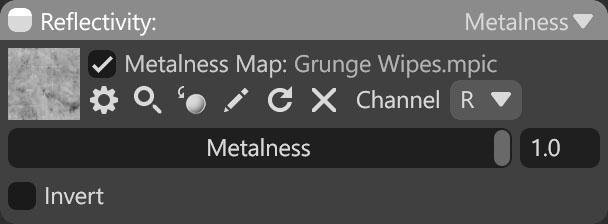Metalness determines whether a material behaves as metallic or non-metallic, affecting how it reflects light. Metallic surfaces reflect their environment with strong specular highlights and little to no diffuse color. Non-metallic (dielectric) surfaces reflect less light, relying more on diffuse reflection to define their appearance.
This shading model uses a Metalness Map (Grayscale). White areas represent metallic surfaces, while black areas represent non-metallic surfaces. Gray values can be used for blending in special cases, but are uncommon in most PBR workflows.
Use cases include:
- Defining metal vs. non-metal regions in complex models.
- Controlling reflectivity in PBR workflows.
- Creating realistic surfaces such as steel, aluminum, copper, plastic, or wood.
Metalness maps can be created in several ways:
- Bake Projects in Toolbag: Generate maps from high-resolution source data.
- Toolbag Library: Use pre-made textures.
- Texture Projects in Toolbag: Paint or procedurally generate maps.
- Third-Party Applications: Author maps externally.

| Setting | Description |
|---|---|
| Metalness Map Texture Slot | Add a metalness texture by clicking on the slot or dragging and dropping one from the Library. |
| Channel Selection | Determines which channel of the texture map will be used. It’s useful when, instead of using multiple single textures, you use one texture with different grayscale maps in the different texture channels: Red, Green, Blue, and Alpha. |
| Metalness Value | Sets the metalness value, which should generally be 0 for insulators or 1 for metals. When a metalness map is loaded, this value should be set to 1. |
| Invert | Inverts the metalness value so that white defines insulators, and black defines metals. |

